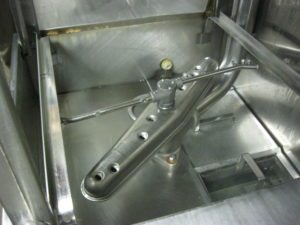Cleanliness is one of the most important attributes to maintain in any commercial dish room. Clean and well maintained warewashing equipment helps to prevent untimely repairs, but most importantly—gives your foodservice operation clean, sanitary ware.
From an operational standpoint, warewashers are one of the most expensive pieces of equipment in your commercial kitchen. For that reason, establishing a daily cleaning procedure is critical to extend the life of your warewasher and prevent downtime.
The manufacturer of your warewasher will outline cleaning best practices specific to your machine type in the operator’s manual provided with the machine, but the following procedures generally apply to all warewashers.
At the end of each shift or washing period, the following steps should be carried out:
- Turn off. Remove the rack (if applicable) and push the machine’s ‘off’ button to shut down the machine.
- Drain tank(s). Open the machine’s door(s) and drain it by lifting the drain lever or by opening the manual drains.
- Scrap basket and strainer pans. Remove and empty the scrap basket and strainer pans. Wash and rinse them thoroughly.
- Interior. Thoroughly clean and flush the warewasher’s interior (use a spray hose if available). Remove any residual food soil soil from the interior walls, corners and door guides with a soft cloth or gentle brush using mild cleanser; rinse again. Check for worn curtains and broken conveyor peg links (if applicable). Do a final visual check for general obstructions.
- Pump cover. Clean with a soft cloth or gentle brush. Do not allow food soil to accumulate on the tank bottom, tank sides or enter the drain. A drain obstruction will prevent proper drain closing, resulting in insufficient wash water, which equates to dishes not getting clean.
- Overflow tube. Remove the overflow tube (i.e., standpipe) within the machine’s tank. Wash and rinse this tube inside and out.
- Wash and rinse arms. Remove and check wash arms and rinse nozzles to make sure they are free of any lime scale, food solids or obstructions like straws and lemon seeds.
- Replace parts. All removed parts should be properly assembled back into the machine. Make sure the scrap basket aligns properly.
- Exterior. Wipe down the exterior of the machine with a soft cloth. Never use steel wool to clean warewasher surfaces; use only products that are safe on stainless steel surfaces.
- Air out. Leave machine door(s) open to allow the interior to air dry overnight.
As a final best practice, clean the floor around the base of the warewasher and under the tabling if prevent soil accumulation.
If you want to extend the life of your warewasher, pay special attention to the daily cleaning procedures of the machine. You can have the best, most state-of-the-art warewasher, but if the human element is not working in concert, even the best intentions can be defeated. Always remember that a clean warewasher is a well-maintained warewasher, and you can’t get properly cleaned ware out of a dirty machine! Follow these simple care and maintenance instructions, and you will help to preserve your investment for years to come.





